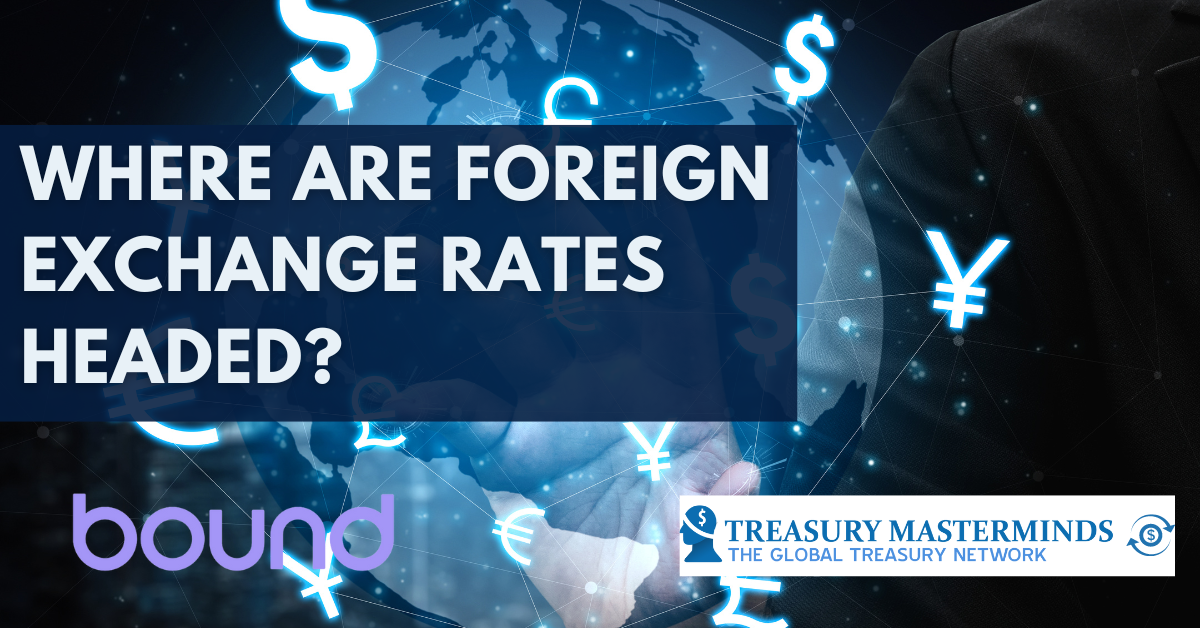
This article is a contribution from one of our content partners, Bound
Introduction
You know, we talk to a lot of people about exchange rates. One question we get all the time is where rates are going to go. First thing I want to be clear about here is that Bound is not in the business of trying to predict where rates are going to go.
But one question that comes up a lot is what should be the default assumption? Where exchange rates will go if I want to assume nothing in terms of changes in supply and demand, volatility, and global macroeconomic changes.
Bound’s Role and Services
So I want to talk a little bit about how Bound thinks about that. The first thing I want to be clear about is what Bound is in the business of doing. Of course, we help companies make their foreign cash flows more stable and predictable.
If you have unbound cash flows, so cash flows that just bounce around with the exchange rates, you can use one of our three automated programmes to make those cash flows more stable and predictable:
- Forwarding: You can lock the rate for a period of time.
- Averaging: You can move to a slow, trending, trailing average.
- Ranging: You can put in control barriers to make sure it keeps the rate inside a certain range.

The Flat Rate Assumption and Interest Rate Differentials
But let’s get to the main question at hand here, which is, what should the assumption be if I assume zero volatility? A lot of people assume it’s going to be the same.
Rates have been moving around over the last couple of years, and I know it’s not going to stay the same as we go into the future, but because I can’t predict it, I’m just going to assume that it’s going to stay the same. Because it’s just as likely to go up as it is to go down, so that’s my safest assumption.
That ignores one really important principle, which is the interest rate on the two currencies, and that creates what’s called the forward curve. So let’s pretend we’re doing a trade today, dollars for euros, and then a year from now we’re trading those back. The current exchange rate today is about 110, so we would exchange 110 dollars for 100 euros.
If the interest rates on those two currencies were exactly the same, we would just swap that money back. But since the dollar earns more interest over the course of the year, we can’t just swap those back and have that be fair, or whoever got the dollars on January 1st is in a way better position.
So what we do instead is to take into consideration the interest earned over the course of the year, and the exchange rate needs to change. So in this example, the 110 becomes 115. The 100 euros become 103. The exchange rate needs to move, from 110 to 1.1214, to compensate for that small difference.
Understanding the Forward Curve
So that is the essence of the forward curve. Let’s take a look at a couple of real forward curves here. And again, this is the assumption that this is not about volatility. This is not about if the economy is going to strengthen or anything. This is just today’s exchange rate and the adjustment we need to make for the fact that these currencies have different interest rates on them.
So you can see Pound<>Euro is going to dip a little bit, Dollar<>Swedish Krona is going to stay pretty level but come down, Euro<>USD and USD<>Brazilian Real are both going to go up. Because the Brazilian Real is quite a high-interest-rate currency relative to US dollars. And so this is almost a 5 percent adjustment over the course of the next 12 months, in where that exchange rate will go strictly because of the interest rate.
So if supply and demand don’t change, if the economies of the US and Brazil stay exactly the same, there’s nothing else that changes. This is where a rational person would assume, just based on the interest rates, where this exchange rate would change.
Misconceptions About Hedging
That could be good for me or bad for me, depending on if I’m buying or selling BRL. Some people assume that this is a cost of hedging, saying, if I hedge the rate out a year from now, that rate could be potentially a lot worse for me. So I’m not going to hedge at all; I’m just gonna assume that it’s gonna be flat.
But assuming that it’s flat is essentially making the assumption that it’s going to be volatile and it’s going to be volatile in the right direction to hold that flat because you’ll be fighting against the interest rate differences across these two currency pairs over the course of that whole year.
The way Bound tends to think about volatility and exchange rates is that the default assumption is the forward curve itself, and volatility revolves not around a flat line but around the forward curve.
Join our Treasury Community
Treasury Masterminds is a community of professionals working in treasury management or those interested in learning more about various topics related to treasury management, including cash management, foreign exchange management, and payments. To register and connect with Treasury professionals, click [HERE] or fill out the form below.